Not So Fast for U.S. Economy, Inflation and therefore Fed Tightening
Economics / Economic Recovery Feb 22, 2010 - 03:31 PM GMTBy: Paul_L_Kasriel
 Not so fast for the economy, for inflation and, therefore, for Fed tightening. The Commerce Department's first guess at Q4:2009 real GDP growth of 5.7% is likely to be the fastest quarterly annualized growth we see for some time. Rather, sequential annualized growth rates over the first three quarters of this year are going to be on the order of less than one-half that of the last year's fourth quarter. Although one month does not a trend make, consumer inflation in January already shows signs of abating a bit.
Not so fast for the economy, for inflation and, therefore, for Fed tightening. The Commerce Department's first guess at Q4:2009 real GDP growth of 5.7% is likely to be the fastest quarterly annualized growth we see for some time. Rather, sequential annualized growth rates over the first three quarters of this year are going to be on the order of less than one-half that of the last year's fourth quarter. Although one month does not a trend make, consumer inflation in January already shows signs of abating a bit.
The dollar is on the ascent against major currencies. It is good to have poor competitors. So, other than a cosmetic increase in the discount rate, which has no current policy significance, the Fed will likely find no pressing need to tighten monetary policy this year. This is the major change in our forecast from last month. We are pushing our projection of the first Fed tightening out from August of this year to January of 2011.
Let's begin by talking about that estimated 5.7% annualized growth in real GDP for Q4:2009. About 58% of that growth is attributed to a sharp slowing in the rate of inventory liquidation. Although the behavior of inventories counts in the GDP box score, the issue is how many more quarters in the near term will the behavior of inventories make such a large contribution to economic activity. Further slowing in inventory accumulation depends on accelerating final demand for goods and services. Shown in Chart 1 is the change in the growth of real final sales of domestic product (which includes export demand) and real final sales to domestic purchasers (which excludes export demand). For both definitions of final demand, growth accelerated in the second quarter of last year. This induced the reduced rate of inventory liquidation in the fourth quarter. But the change in the growth of final demand slowed in the third and fourth quarter of last year. And the change in the growth of final demand on the part of domestic purchasers went negative in the fourth quarter.
Chart 1
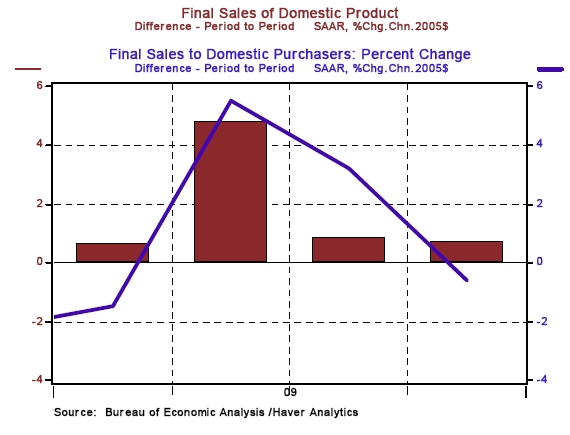
The near-term probability of a significant acceleration in the growth of final demand is low because the banking system still is contracting credit. Shown in Chart 2 is the year-over-year percentage change in bank credit - bank loans and bank holdings of securities - deflated by the Consumer Price Index. In the 12 months ended January 2010, "real" bank credit contracted at an annualized rate of 6.1%, the most severe rate of contraction since the Carter administration imposed credit controls in 1980. Bank credit contraction of this magnitude is not conducive to an acceleration in the growth of real final demand.
Chart 2
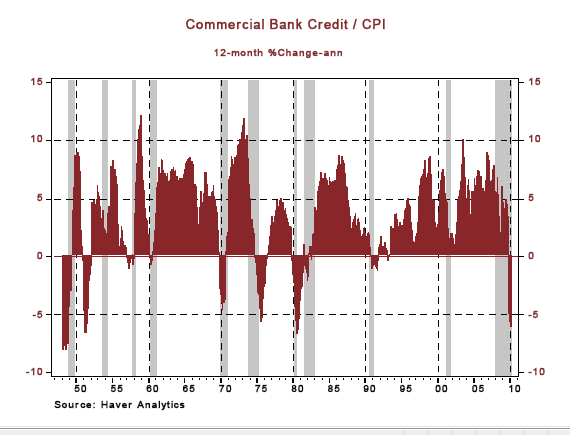
Real GDP growth in Q4:2009 also was significantly boosted by a 13.3% annualized rate of growth in real expenditures on business equipment and software. Part of this outsized increase in business capital spending looks suspicious - the 579% annualized increase in real expenditures for trucks, buses and truck trailers (see Chart 3). This increased spending on trucks and buses accounted for almost 51% of the increase in total real expenditures on business equipment and software. One explanation of this surge in truck buying might be the December 2009 expiration of a first-year bonus depreciation program for tax purposes. We expect continued growth in capital spending in 2010, but at a much more subdued pace as businesses gear down their truck purchases.
Chart 3
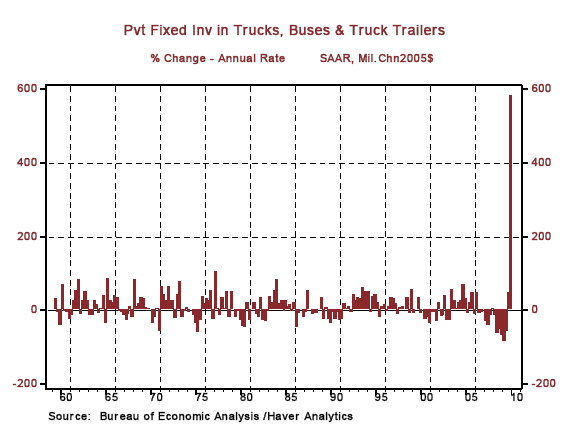
The housing market recovery also is slowing. Housing completions, which had stabilized earlier in 2009, now are resuming a downward slide (see Chart 4). And sales of new houses also have weakened in recent months (see Chart 5).
Chart 4
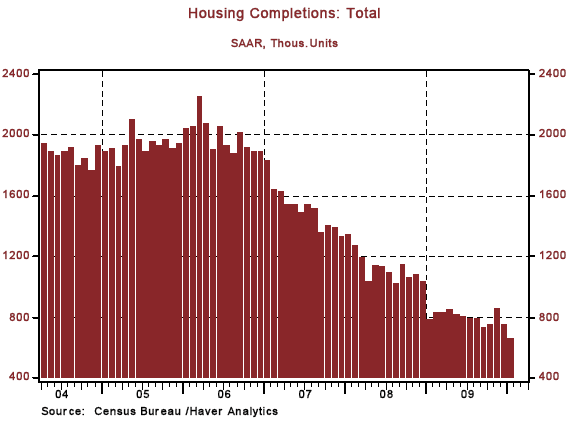
Chart 5
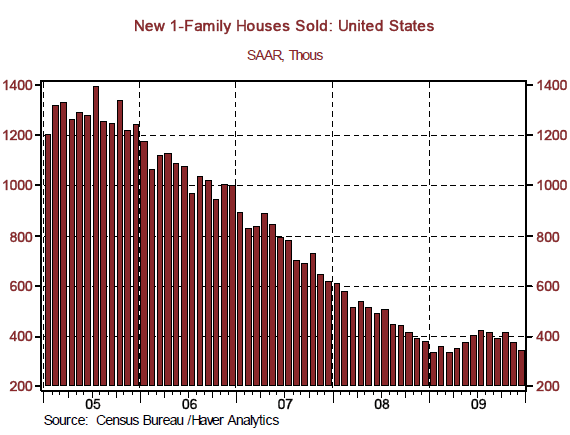
Although the motor vehicle industry has estimated sales of cars and light trucks of 12 million units in 2010, sales are off to a slow start. In January, total sales downshifted to an annualized pace of 10.8 million units from December's pace of 11.2 million units (see Chart 6). Although not necessarily for fundamental reasons, but February's car and truck sales could have slowed further due to Toyota's problems. Nominal retail sales excluding auto and gasoline sales, the latter of which are highly volatile because of price changes, are on a course to grow in the first quarter at about the same rate as they did in last year's fourth quarter. So, when adding back in weaker unit car and truck sales, first quarter real growth in personal consumption expenditures could come up a bit short of last year's fourth quarter 2.0% annualized growth.
Chart 6
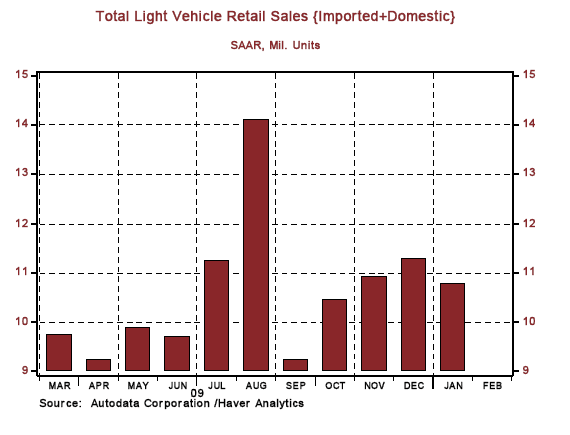
State & local government real expenditures on infrastructure projects got a boost from Build America Bonds (BABs), an element of last year's fiscal stimulus program. BABs are taxable to their purchasers, but the state & local government issuers receive an interest rate rebate from the Treasury. In some cases, the effective cost of borrowing via BABs is lower than what it would be if tax exempt bonds were issued. BABs undoubtedly stimulated state & local government infrastructure spending. But even if you are borrowing at a zero interest rate, as a matter of principle, you still are expected to pay back the principal on bonds. And because many state & local governments are now facing deficits in their day-to-day operating budgets, not to mention an aggregate $1 trillion underfunding of public employee pension plans according to the Pew Center on the States, it is no wonder that infrastructure spending spree by state & local governments is over (see Chart 7).
Chart 7
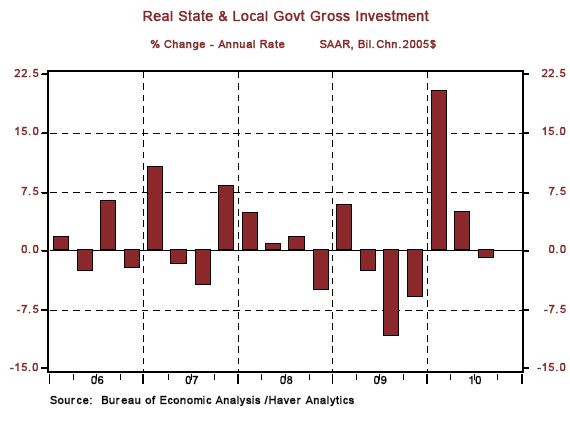
Although prices of consumer goods and services are increasing, there is little evidence that the rate of increase is accelerating or that it will in 2010. The 12-month annualized rate of increase in the CPI did pick up in the latter months of 2009, but moderated marginally in January of this year (see Chart 8). When examined on a month-to-month basis using the Cleveland Fed's "Trimmed-Mean" CPI, which throws out the eight percent of the weighted components with the largest one-month price changes and the eight percent with the smallest price changes, consumer price inflation in recent months has a slight downward tilt to it (also see Chart 8).
Chart 8
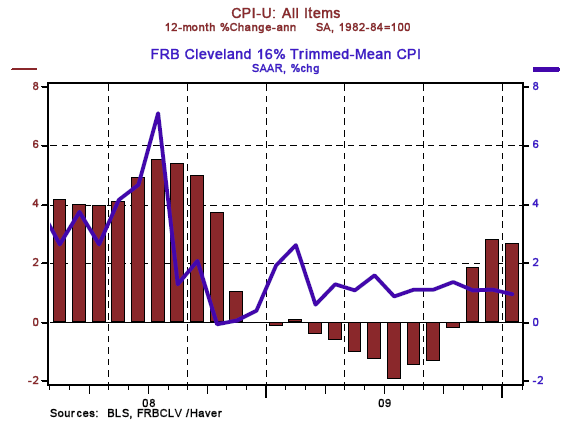
Among other things, Milton Friedman taught us that inflation is always and everywhere a monetary phenomenon. That is, without rapid money supply growth there cannot be persistent high inflation. Despite the ballooning of the Fed's balance sheet, growth in the M2 money supply in the 12 months ended January is a paltry 1.9% annualized - hardly the stuff of high inflation much less an acceleration in inflation (see Chart 9).
Chart 9
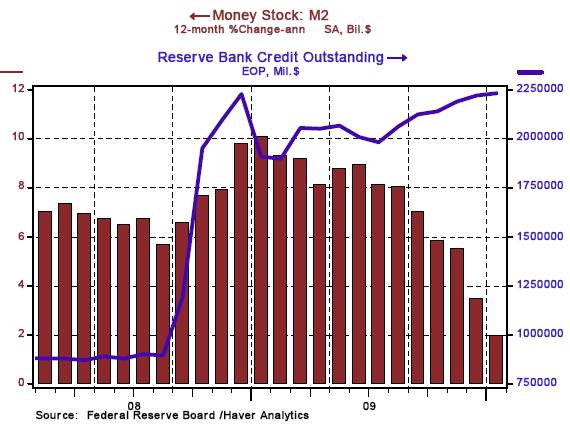
For those who disagree with the late Milton Friedman and believe that inflation is a cost-push phenomenon, largely related to labor costs, Chart 10 shows that total compensation of private industry workers grew at an annualized rate of 1.2% in the 12 months ended December 2009, the slowest growth in 30 years. Given the relatively slow real GDP growth we expect in 2010 (2.6% Q4-over-Q4) and thus, the persistence of a high unemployment rate, there is little chance that labor costs will spike in the foreseeable future and drive up consumer inflation.
Chart 10
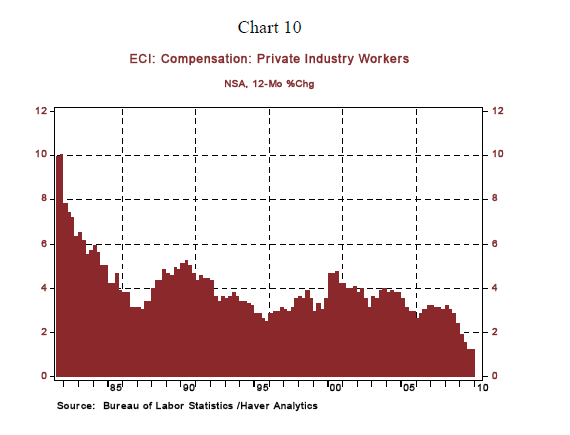
So, if we are correct that monetary policy is tight given the contraction in real bank credit and the very slow growth in the nominal supply of money, despite a federal funds rate of about 1/8 %, then both real and nominal economic growth will be muted this year. The 5.7% annualized growth in real GDP in Q4:2009 was largely a one-off event. Under these circumstances, there is no rush for the Fed to start tightening monetary policy.
The Fed has articulated its "exit" strategy for "neutralizing" the over $1 trillion of excess reserves in the banking system it has created in the past two years. The main tool the Fed will employ to induce banks to keep holding excess reserves when private credit demand picks up and the banking system's capital is adequate to allow it to begin creating credit is the interest rate it is now allowed to pay on bank reserves. The Fed will lift the rate it pays on reserves. No bank will lend to the private sector at an interest rate equal to or less than the rate it can earn on excess reserves at the Fed with no default risk.
Of course, the question remains as to what level the Fed will have to raise the interest rate it pays on bank reserves to prevent an inflationary amount of bank credit from being created. But this is the same question the Fed faced when it was using the federal funds rate as its principal policy lever. As mentioned at the outset, we now believe that the Fed will not begin its tightening sequence until January 2011. Previously, we had put the commencement of tightening at August 2010. We take the Fed at its word that last week's increase in the discount rate had no policy significance. Rather, it was a just one more indication that the interbank funding market is almost back to normal. As a result, banks are able to fund themselves in the interbank loan market and no longer need a subsidized discount window for funding.
Paul Kasriel is the recipient of the 2006 Lawrence R. Klein Award for Blue Chip Forecasting Accuracy
by Paul Kasriel and Asha Bangalore
The Northern Trust Company
Economic Research Department - Daily Global Commentary
Copyright © 2010 Paul Kasriel
Paul joined the economic research unit of The Northern Trust Company in 1986 as Vice President and Economist, being named Senior Vice President and Director of Economic Research in 2000. His economic and interest rate forecasts are used both internally and by clients. The accuracy of the Economic Research Department's forecasts has consistently been highly-ranked in the Blue Chip survey of about 50 forecasters over the years. To that point, Paul received the prestigious 2006 Lawrence R. Klein Award for having the most accurate economic forecast among the Blue Chip survey participants for the years 2002 through 2005.
The opinions expressed herein are those of the author and do not necessarily represent the views of The Northern Trust Company. The Northern Trust Company does not warrant the accuracy or completeness of information contained herein, such information is subject to change and is not intended to influence your investment decisions.
Paul L. Kasriel Archive |
© 2005-2022 http://www.MarketOracle.co.uk - The Market Oracle is a FREE Daily Financial Markets Analysis & Forecasting online publication.



